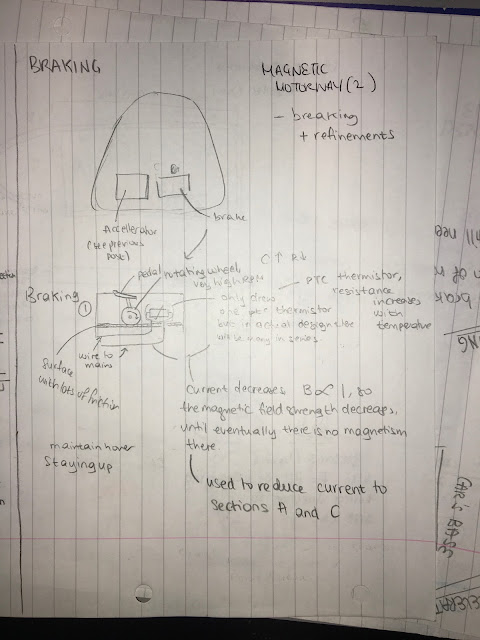WHAT IF- Magnetic Motorways (part 2)
Hi Readers,
Soooooo...
I have finally come up with some ideas for the breaking. The steering is also done, but my drawing of it is simply atrocious so I will redraw it the next time I come around to doing it.
Like before, I will simply insert images of the sections, and do a bit of description with it too. I still suggest you read the text in the pictures - I did try to annotate most of the images, and I think on this occasion (thankfully) my hand writing is in fact better.
Soooooo...
I have finally come up with some ideas for the breaking. The steering is also done, but my drawing of it is simply atrocious so I will redraw it the next time I come around to doing it.
Like before, I will simply insert images of the sections, and do a bit of description with it too. I still suggest you read the text in the pictures - I did try to annotate most of the images, and I think on this occasion (thankfully) my hand writing is in fact better.
I have defined what the base of the car is composed off. The main base is what helps it to hover, and the cover controls are made up of very strong electromagnetic patches, that are concentrated in the centre of the section, to avoid causing attraction to opposite parts of the road.
Section A is the weakly attracting/repelling base, which is required to keep the car moving.
Section C is not part of the main base of the car, but it is at the front of the car. The strength of the electromagnetic base here increases towards to the front of the car, which is to ensure that it attracted to the next section of the road. I will have to weight it to ensure that it does not ti up every time the driver accelerates.
I have also revised that the sections of the road of opposing polarity are 50m. I think 10m will probably be better, as firstly a magnetic field that is still strong enough to attract a vehicle at 50m away from it will not only not be safe, but also would not be feasible.
Sections A, B and C are made up of electromagnets, and the sections are seperated by magnetic shielding. To my dismay, I found that there are actually no materials that block out magnetism, but magnetic shielding can be very effective to ensure that magnetic field lines don't interfere in different components. You can see that in my drawing of the main base (side profile), the magnetic sections are made up of many electromagnets (note that the sections B have coils with more turns as they are the section with the strongest magnetic field strength).
This section defines what happens when braking. When braking, much like accelerating, the user will press the brake pedal, which wiLl press down on a wheel in rotation. This will rub against a rough material that will get hot. A thermistor will also be used here, but this will be a ptc thermistor, so as temperature increases the resistance will also increase, reducing the current to the sections A, C and D. This will demagnetise the sections so there is no polarity. Section B will be the only thing in operation, and will enable the car to remain hovering.
In the next two weeks, I will need to:
- find out more about magnetic shielding
- properly draw the steering controls
- Figure out starting and stopping controls
- Rethink how the car magnets will change polarisation as the car moves across different sections of road.
And until then, I hope you all have a blessed fortnight :)
EO



Comments
Post a Comment